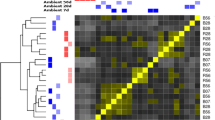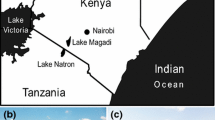Abstract
During their many millions of years of evolution in the extreme and stable cold, Antarctic notothenioid fishes have acquired profoundly cold-adapted physiologies. Gene expression profiling via cDNA microarray was used to determine the extent to which one species of notothenioid, Trematomus bernacchii, has retained the ability to alter gene expression in response to heat stress. While an inability to up-regulate the expression of any size class of heat shock proteins (except for a 1.1-fold induction of the co-chaperone Hsp40) was observed, hundreds of additional genes, associated with a broad range of cellular processes, were responsive to heat. Many of these genes are associated with central aspects of the evolutionarily conserved cellular stress response (CSR), which plays a pivotal role in responding to physical and chemical stresses. The inability of T. bernacchii to mount a heat shock response underscores the potential susceptibility of this species to the effects of global warming.


Similar content being viewed by others
References
Afonso LOB, Hosoya J, Osborne J, Gamperl AK, Johnson S (2008) Lack of glucose and hsp70 responses in haddock Melanogrammus aeglefinus (L.) subjected to handling and heat shock. J Fish Biol 72:157–167
Aldsworth TG, Sharman RL, Dodd CE (1999) Bacterial suicide through stress. Cell Mol Life Sci 56:378–383
Bucciantini M, Giannoni E, Chiti F, Baroni F, Formigli L, Zurdo J, Taddel N, Ramponi G, Dobson CM, Stefani M (2002) Inherent toxicity of aggregates implies a common mechanism for protein misfolding diseases. Nature 416:507–511
Buckley BA (2007) Comparative environmental genomics in non-model species: using heterologous hybridization to DNA-based microarrays. J Exp Biol 210:1602–1606
Buckley BA, Place SP, Hofmann GE (2004) Regulation of heat shock genes in isolated hepatocytes from an Antarctic fish, Trematomus bernacchii. J Exp Biol 207:3649–3656
Buckley BA, Gracey AY, Somero GN (2006) The cellular response to heat stress in the goby Gillichthys mirabilis: a cDNA microarray and protein-level analysis. J Exp Biol 209:2660–2677
Cheng CHC, Cziko PA, Evans CW (2006) Non-hepatic origin of notothenioid antifreeze reveals pancreatic synthesis as common mechanism in polar fish freezing avoidance. Proc Natl Acad Sci USA 103:10491–10496
Chernikov AV, Gudkov SV, Shtarkman IN, Bruskov VI (2007) Oxygen effect in heat-induced DNA damage. Biophysics 52:185–190
Ciechanover A (1998) The ubiquitin-proteasome pathway: on protein death and cell life. EMBO J 17:7151–7160
Clark MS, Clarke A, Cockell CS, Convey P, Detrich HWIII, Fraser KPP, Johnston IA, Methe BA, Murray AE, Peck LS, Römisch K, Rogers AD (2004) Antarctic genomics. Comp Funct Genom 5:230–238
Clark MS, Fraser KPP, Burns G, Peck LS (2008a) The HSP70 heat shock response in the Antarctic fish Harpagifer antarcticus. Polar Biol 31:171–180
Clark MS, Fraser KPP, Peck LS (2008b) Lack of an Hsp70 heat shock response in two Antarctic marine invertebrates. Polar Biol. doi: 10.1007/s00300-008-0447-7
Coppes Petricorena ZL, Somero GN (2007) Biochemical adaptations of notothenioid fishes: comparisons between cold temperate South American and New Zealand species and Antarctic species. Comp Biochem Physiol A 147:799–807
DeVries A (1971) Glycoproteins as biological antifreeze agents in Antarctic fishes. Science 172:1152–1155
Di Ciano C, Nie Z, Szaszi K, Lewis A, Uruno T, Zhan X, Rotstein OD, Mak A, Kapus A (2002) Osmotic stress-induced remodeling of the cortical cytoskeleton. Am J Physiol Cell Physiol 283:C850–C865
Feder ME, Hofmann GE (1999) Heat-shock proteins, molecular chaperones, and the stress response: evolutionary and ecological physiology. Annu Rev Physiol 61:243–282
Fields PA, Somero GN (1998) Hot spots in cold adaptation: localized increases in conformational flexibility in lactate dehydrogenase A4 orthologs of Antarctic notothenioid fishes. Proc Natl Acad Sci USA 95:11476–11481
Fink AL (1999) Chaperone-mediated protein folding. Physiol Rev 79:425–449
Gasch AP, Spellman PT, Kao CM, Carmel-Harel O, Eisen MB, Storz G, Botstein D, Brown PO (2000) Genomic expression programs in the response of yeast cells to environmental change. Mol Biol Cell 11:4241–4257
Gracey AY (2007) Interpreting physiological responses to environmental change through gene expression profiling. J Exp Biol 210:1584–1592
Gracey AY (2008) The Gillichthys mirabilis Cooper array: a platform to investigate the molecular basis of phenotypic plasticity. J Fish Biol 72:2118–2132
Gracey AY, Cossins AR (2003) Application of microarray technology in environmental and comparative physiology. Annu Rev Physiol 65:231–259
Gracey AY, Troll JV, Somero GN (2001) Hypoxia-induced gene expression profiling in the euryoxic fish Gillichthys mirabilis. Proc Natl Acad Sci USA 98:1993–1998
Gracey AY, Fraser EJ, Li W, Fang Y, Taylor RR, Rogers J, Brass A, Cossins AR (2004) Coping with cold: an integrative, multitissue analysis of the transcriptome of a poikilothermic vertebrate. Proc Natl Acad Sci USA 101:16970–16975
Hazel J (1995) Thermal adaptation in biological membranes: is homeoviscous adaptation the explanation? Ann Rev Physiol 57:19–42
Hofmann GE, Gaines SD (2008) New tools to meet new challenges: emerging technologies for managing marine ecosystems for resilience. BioScience 58:43–52
Hofmann GE, Place S (2007) Genomics-enabled research in marine ecology: challenges, risks and pay-offs. Mar Ecol Prog Ser 332:249–255
Hofmann GE, Buckley BA, Airaksinen S, Keen JE, Somero GN (2000) Heat shock protein expression is absent in the Antarctic fish, Trematomus bernacchii (Family Nototheniidae). J Exp Biol 203:2331–2339
Kassahn KS, Caley MJ, Ward AC, Connolly AR, Stone G, Crozier RH (2007) Heterologous hybridization to study the early gene response to heat stress in a coral reef fish. Mol Ecol 16:1749–1763
Kawai T, Matsumoto M, Takeda K, Sanjo H, Akira S (1998) ZIP kinase, a novel serine/threonine kinase which mediates apoptosis. Mol Cell Biol 18:1642–1651
Kennett JP (1977) Cenozoic evolution of Antarctic glaciation, the circum-Antarctic Ocean, and their impact on global paleooceanography. J Geophys Res 82:3843–3860
Kültz D (1998) Phylogenetic and functional classifications of mitogen- and stress-activated protein kinases. J Mol Evol 46:571–588
Kültz D (2003) Evolution of the cellular stress proteome: from monophyletic origin to ubiquitous function. J Exp Biol 206:3119–3124
Kültz D (2005) Molecular and evolutionary basis of the cellular stress response. Annu Rev Physiol 67:225–257
Lang F, Cohen P (2001) Regulation and physiological roles of serum- and glucocorticoid-induced protein kinase isoforms. Science STKE 2001:RE17
LaTerza A, Passini V, Barchetta S, Luporini P (2007) Adaptive evolution of the heat shock response in the Antarctic psychrophilic ciliate, Euplotes focardii: hints from a comparative determination of the hsp70 gene structure. Ant Sci 19:239–244
Lindquist S (1986) The heat-shock response. Annu Rev Biochem 55:1151–1191
National Research Council (2003) Frontiers in polar biology in the genomic era. National Academy Press, Washington, DC (http://www.nap.edu/catalog/10623.html)
Norbury CJ, Zhivotovsky B (2004) DNA damage-induced apoptosis. Oncogene 23:2797–2808
Place SP, Hofmann GE (2005a) Constitutive expression of a heat shock protein, hsp70, in phylogenetically divergent Antarctic fish. Polar Biol 28:261–267
Place SP, Hofmann GE (2005b) Comparison of hsc71 orthologs from polar and temperate notothenioid fishes: differences in prevention of aggregation and refolding of denatured proteins. Am J Physiol Regul Integr Comp Physiol 288:R1195–R1202
Podrabsky JE, Somero GN (2004) Changes in gene expression associated with acclimation to constant temperature and fluctuating daily temperatures in an annual killifish Austrofundulus limnaeus. J Exp Biol 207:2237–2254
Podrabsky JE, Somero GN (2006) Inducible heat tolerance in Antarctic notothenioid fishes. Polar Biol 30:39–43
Ramji DP, Foka P (2002) CCAAT/enhancer-binding proteins: structure, function and regulation. Biochem J 365:561–575
Renn SCP, Aubin-Horth N, Hofmann HA (2004) Biologically meaningful expression profiling across species using heterologous hybridization to a cDNA microarray. BMC Genomics 5(1):42. doi:10.1186/1471-2164/5/42
Rinehart JP, Hayward SAL, Elnitsky MA, Sandro LH, Lee RE Jr, Denlinger DL (2006) Continuous up-regulation of heat shock proteins in larvae, but not adults, of a polar insect. Proc Natl Acad Sci USA 103:14223–14227
Sheikh MS, Hollander MC, Fornance AJ (2000) Role of Gadd45 in apoptosis. Biochem Pharmacol 59:43–45
Smith ML, Fornance AJ (1996) Mammalian DNA damage-inducible genes associated with growth arrest and apoptosis. Mutat Res Rev Genet Toxicol 340:109–124
Somero GN, DeVries AL (1967) Temperature tolerance of some Antarctic fishes. Science 156:257–258
Somero GN, Giese AC, Wohlschlag DE (1968) Cold adaptation of the Antarctic fish Trematomus bernacchii. Comp Biochem Physiol 26:223–233
Sorenson JG, Nielsen MM, Kruhoffer M, Justesen J, Loeschke V (2005) Full genome gene expression analysis of the heat stress response in Drosophila melanogaster. Cell Stress Chaper 7:97–106
Takahashi Y (2003) The 14-3-3 proteins: gene, gene expression and function. Neurochem Res 28:1265–1273
Taylor WR, Stark GR (2001) Regulation of the G2/M transition by p53. Oncogene 20:1803–1815
Teranishi KS, Stillman JH (2007) A cDNA microarray analysis of the response to heat stress in hepatopancreas tissue of the porcelain crab Petrolisthes cinctipes. Comp Biochem Physiol D 2:53–62
Todgham AE, Hoaglund EA, Hofmann GE (2007) Is cold the new hot? Elevated ubiquitin-conjugated protein levels in Antarctic fish as evidence for cold-denaturation of proteins in vivo. J Comp Physiol B 177:857–866
Vornanen M, Hassinen M, Koskinen H, Krasnov A (2005) Steady-state effects of temperature acclimation on the transcriptome of the rainbow trout heart. Am J Physiol Regul Integr Comp Physiol 289:R1177–R1184
Waldegger S, Barth P, Raber G, Lang F (1997) Cloning and characterization of a putative human serine/threonine protein kinase transcriptionally modified during anisotonic and isotonic alterations of cell volume. Proc Natl Acad Sci USA 94:4440–4445
Acknowledgments
This work was supported by NSF-OPP Fellowship Award 0443754 to BAB and NSF-OPP Award OPP05-04072 to Dr. Donal Manahan for the Antarctic Biology Course. Our appreciation goes to Dr. Gretchen Hofmann and the members of B-134 for field assistance.
Author information
Authors and Affiliations
Corresponding author
Rights and permissions
About this article
Cite this article
Buckley, B.A., Somero, G.N. cDNA microarray analysis reveals the capacity of the cold-adapted Antarctic fish Trematomus bernacchii to alter gene expression in response to heat stress. Polar Biol 32, 403–415 (2009). https://doi.org/10.1007/s00300-008-0533-x
Received:
Revised:
Accepted:
Published:
Issue Date:
DOI: https://doi.org/10.1007/s00300-008-0533-x




